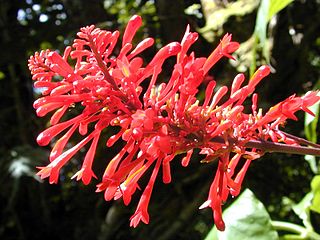
Acanthaceae is a family of dicotyledonous flowering plants containing almost 250 genera and about 2500 species. Most are tropical herbs, shrubs, or twining vines; some are epiphytes. Only a few species are distributed in temperate regions. The four main centres of distribution are Indonesia and Malaysia, Africa, Brazil, and Central America. Representatives of the family can be found in nearly every habitat, including dense or open forests, scrublands, wet fields and valleys, sea coast and marine areas, swamps, and mangrove forests.

Justicia is a genus of flowering plants in the family Acanthaceae. It is the largest genus within the family, encompassing around 700 species with hundreds more as yet unresolved. They are native to tropical to warm temperate regions of the Americas, India and Africa. The genus serves as host to many butterfly species, such as Anartia fatima. Common names include water-willow and shrimp plant, the latter from the inflorescences, which resemble a shrimp in some species. The generic name honours Scottish horticulturist James Justice (1698–1763). They are closely related to Pachystachys.
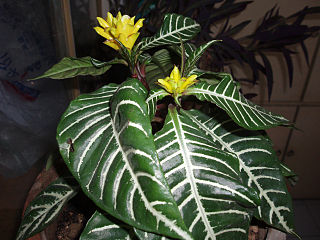
Aphelandra is a genus of about 170 species of flowering plants in the family Acanthaceae, native to tropical regions of the Americas.

Siproeta stelenes (malachite) is a Neotropical brush-footed butterfly. The malachite has large wings that are black and brilliant green or yellow-green on the upperside and light brown and olive green on the underside. It is named for the mineral malachite, which is similar in color to the bright green on the butterfly's wings. Typically, the wingspread is between 8.5 and 10 cm. The malachite is found throughout Central and northern South America, where it is one of the most common butterfly species. Its distribution extends as far north as southern Texas and the tip of Florida, to Cuba as subspecies S. s. insularis, and S. s. biplagiata, and south to Brazil.

Taxus brevifolia, the Pacific yew or western yew, is a species of tree in the yew family Taxaceae, native to the Pacific Northwest of North America. It ranges from southernmost Alaska south to central California, mostly in the Pacific Coast Ranges, but with isolated disjunct populations in southeast British Columbia and in north to central Idaho.
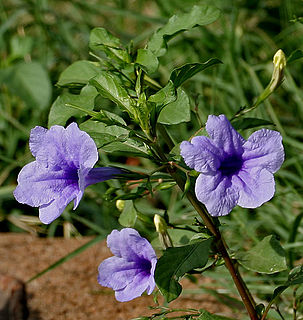
Ruellia is a genus of flowering plants commonly known as ruellias or wild petunias. They are not closely related to petunias (Petunia) although both genera belong to the same euasterid clade. The genus was named in honor of Jean Ruelle, herbalist and physician to Francis I of France and translator of several works of Dioscorides.
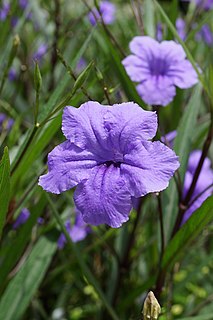
Ruellia simplex, the Mexican petunia, Mexican bluebell or Britton's wild petunia, is a species of flowering plant in the family Acanthaceae. It is a native of Mexico, the Caribbean, and South America. It has become a widespread invasive plant in Florida, where it was likely introduced as an ornamental before 1933.
Ruellia vindex is a plant native to Brazil, Guyana and Venezuela. This plant is cited in Flora Brasiliensis by Carl Friedrich Philipp von Martius.

Ruellia humilis is a species of flowering plant in the family Acanthaceae. It is native to the eastern United States. It is grown as an ornamental plant.
Ruellia dioscoridis is a species of plant in the family Acanthaceae. It is endemic to Yemen. Its natural habitats are subtropical or tropical dry shrubland and subtropical or tropical dry lowland grassland.
Ruellia insignis is a species of plant in the family Acanthaceae. It is endemic to Yemen.
Ruellia kuriensis is a species of plant in the family Acanthaceae. It is endemic to Yemen. Its natural habitat is subtropical or tropical dry shrubland.

Ruellia devosiana, the Brazilian wild petunia, is a green ornamental plant of the family Acanthaceae.

Ruellia caroliniensis, the Carolina wild petunia, is a wild petunia with blue or violet flowers that appear in the spring, summer, and autumn. Its leaves are light green. This species is native to the southeastern United States.
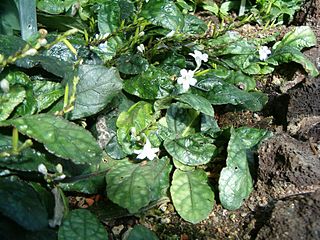
Ruellia drymophila is a plant species in the family Acanthaceae, native to China.

Ruellia tuberosa, also known as minnieroot, fever root, snapdragon root and sheep potato, is a species of flowering plant in the family Acanthaceae. Its native range is in Central America but presently it has become naturalized in many countries of tropical South and Southeast Asia.
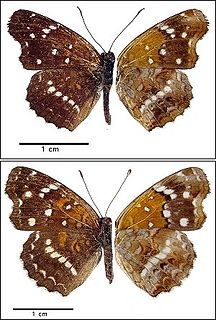
Anthanassa texana, the Texan crescentspot, is a species of butterfly in the family Nymphalidae. It is found from Guatemala north through Mexico to southern California, east across the southern United States to northern Florida, Georgia and South Carolina. Strays may be found up to Arkansas, Missouri, Illinois, South Dakota, and central Nevada. The habitat consists of deserts, dry gulches, open areas, streamsides, road edges, and city parks.
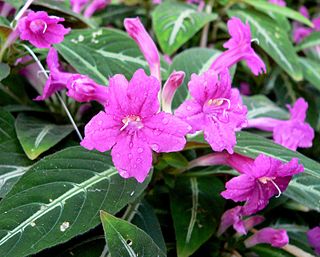
Ruellia makoyana, the monkey plant or trailing velvet plant, is a species of flowering plant in the family Acanthaceae, native to Brazil. It is an evergreen perennial growing to 60 cm (24 in) tall by 45 cm (18 in) wide, with white-veined hairy leaves and trumpet-shaped pink flowers in summer.
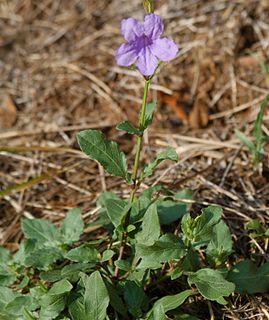
Ruellia nudiflora, the violet wild petunia, is a perennial plant in the acanthus family (Acanthaceae) found in areas of moisture in the Sonoran Desert. Despite its name, it is not a true petunia.
Ruellia noctiflora, the nightflowering wild petunia, is a herbaceous perennial found along the Gulf coast. Both its specific and common names derive from its habit of nocturnal flowering. In spite of the common name it is in a different family from the garden petunia.















